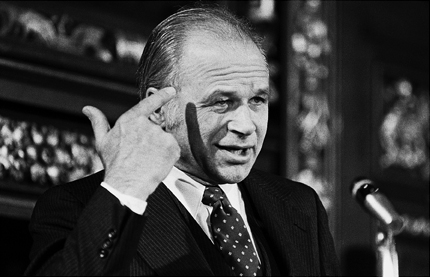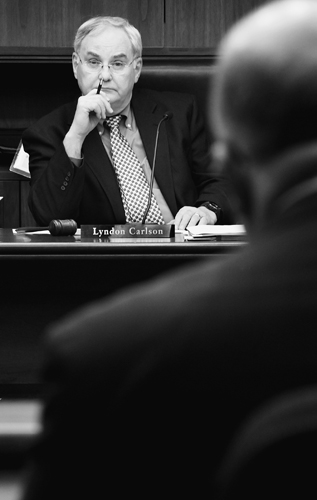At Issue: Been there, done that
By Lee Ann Schutz
 Call it déjà Vu for Rep. Lyndon Carlson Sr.
Call it déjà Vu for Rep. Lyndon Carlson Sr.
The Crystal DFLer was serving his fifth term in the House during the 1981-1982 biennium when the shoe dropped on the economy, sending Minnesota’s unemployment numbers and interest rates skyrocketing, and the farm economy and state’s budget into the tank.
With the state now facing a projected $4.85 billion biennial deficit and increasing unemployment, for Carlson it’s like history repeating itself.
As a member of the House Appropriations Committee and chair of its education division in 1981, he was in the thick of the discussion to balance the $8.2 billion biennial General Fund budget that was sliding into a $778 million hole.
Today, Carlson chairs the 2009 counterpart to the appropriations committee — the House Finance Committee, where any bill with fiscal implications (except for taxes) flows through, thus putting him, once again, smack in the middle of budget discussions. He is open to every piece of advice, but says the past can be a great teacher.
“When thinking about the deficit, I have a tendency to look back to what it took to solve various budgetary problems. You know the old saying that history has a tendency to repeat itself. The fiscal difficulties that we are currently facing rank at least right up there with the early 80s in significance,” Carlson said.
Some similarities can be drawn between the past and present:
• the state’s prior years of financial growth and stability evaporated quickly;
• unemployment numbers began to climb in 1981 before reaching an historic high of nearly 200,000 in 1983; and
• Democrats controlled the House and Senate, and Republican Gov. Al Quie was adamantly against tax increases to solve the budget woes.
 Looking back for solutions
Looking back for solutions
Carlson said he is thinking a lot about his 1981-82 experience — especially the three-pronged approach it took to solve the budget problem, and the six special sessions and two regular sessions it took to do it.
“If we were to look at the early 80s, and I’m not saying that will be the model this time, it was a three-legged stool; there were shifts, mainly in K-12 funding, there were increases in revenue and there were budget reductions,” Carlson said.
Revenue-raising was the key to balancing the budget back then, but it also ended any hopes Quie had for re-election.
Quie had repeatedly stated that tax increases would not be part of any budget-balancing solution, but after the 1981 November Forecast, it was apparent that cuts and shifts weren’t going to be enough. Quie realized that tax increases — a move he knew would be political suicide — were needed to stave off further unacceptable cuts.
“It was the biggest battle I had inside of me,” Quie said in a recent interview.
“It was my calling to be in politics; it was the toughest thing for me to do, to not run. But the state was more important to me. I knew taxes had to be increased to solve the problem.”
By taking himself out of the discussion of raising taxes and the political fallout it would cause, legislators could focus on solving the problem through deferring payments, cutting expenditures and temporarily raising the sales tax and income tax, he said.
 Advice for today
Advice for today
Quie advises legislators to stay true to their principles as they work to resolve today’s budget problems — for him those are funding education and infrastructure.
“Educating kids is a long process — preschool through their early 20s. Funding education is a long-term investment in the state’s future.” As for infrastructure, he said the state has the primary responsibility for maintaining our roads and bridges — another long-term investment that he said pays dividends.
Quie said that before the 1981 recession, Minnesota, because of its diversified economy, seemed insulated from any national economic downturn. But diversity proved no match for that recession, especially when the state was hit hard in farming and mining, and a policy change had left the state with little reserves.
“No one was prepared for a recession that went on and on,” Quie said. “I pushed my finance people to look further into the future.” It seemed as though the problem was solved by one special session, but things just kept getting worse, he said.
This experience is not lost on Carlson.
If the February Forecast — expected to be released in the month’s final week — for the state budget is as dire as expected, Carlson recommends acting quickly to solve the problem. “One of the big problems we encountered in the 80s is that we lost time, thereby limiting options. You can’t raise enough revenue in a short amount of time to offset the problem; you get down to the last few months, and you can’t necessarily downsize your workforce, because you don’t have enough savings to balance the budget,” he said.”
Looking forward
Carlson is optimistic this session can end on time, but he has no illusions of it being an easy process.
“Some members will be opposed to accounting shifts and some will be opposed to any revenue increases. Those of us close to the budget are saying we have to keep all tools on the table, and hopefully reach consensus — and hopefully bipartisan consensus.”
He would caution members to “remain flexible — we have some very difficult decisions to make.”
Session Weekly More...
Related Stories
A done deal
Budget fix makes the best of bad times for the state
(view full story)
Published 6/1/2010
Deal or no deal?
Endgame is unclear as budget talks enter final days
(view full story)
Published 5/13/2010
Unallotment undone
Court decision throws governor, lawmakers a curveball
(view full story)
Published 5/6/2010
Budget cuts, round one
Despite deep spending cuts, legislators try to soften the blow
(view full story)
Published 4/8/2010
Closing the gap
Piece by painful piece, lawmakers begin chipping away at the budget deficit
(view full story)
Published 3/18/2010
A cloudy forecast
State’s new economic projection shows more trouble on the horizon
(view full story)
Published 3/4/2010
Budget battle begins
DFL lawmakers say governor’s budget plan is incomplete, call for ‘Plan B’
(view full story)
Published 2/18/2010
Minnesota Index: The state budget
Figures and statistics on Minnesota's state budget
(view full story)
Published 2/18/2010
Cash flow conundrum
Projected cash shortages will require delicate balancing act
(view full story)
Published 2/11/2010
First Reading: From worse to bad
Stimulus helps, but lawmakers still face a record deficit
(view full story)
Published 3/6/2009
First Reading: 'Tough decisions'
Governor proposes spending cuts, accounting shifts to solve $4.8 billion deficit
(view full story)
Published 1/30/2009
At Issue: Been there, done that
House finance chair, former governor reflect on previous budget problem
(view full story)
Published 1/30/2009
At Issue: Not enough money in the cookie jar
Spending to outpace revenues as state’s population ages, report finds
(view full story)
Published 1/16/2009
First Reading: Deep in the red
Members begin session with multi-billion dollar deficit to overcome
(view full story)
Published 1/9/2009
At Issue: Starting from zero
Lawmakers consider a new approach to building the state budget
(view full story)
Published 1/9/2009